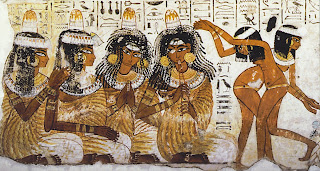Whilst searching for research on Egyptian culture and how they lived there lives I came across this brilliant website, it has ancient paintings and a description of what the painting depicts. This is perfect as it will help me complete the first chapter in our publication in no time at all.
Music and Dance
A tomb painting of two girls dancing to music made by several women. Two of the women clap their hands to keep the rhythm, another plays a double flute, and the second from the left may be a singer. The scene is found in the tomb of Nebamun at Thebes and dates to circa 1400 B.C.E. The part of the painting shown here measures about 11 3/4 inches tall.
Adorning the body
A tomb painting of a servant girl and four elegantly dressed women at a funerary banquet. The guests wear wigs, gold earrings, jeweled collars, bracelets, and pleated dresses. On their heads are scented ones of animal fat that release perfume as they slowly melt. Several women are holding lotus flowers, which were typically distributed to banquet guests as they arrived. This wall painting appears in the tomb of Nebamun at Thebes and dates to about 1400 B.C.E.
Burial Practices
A scene drawn on papyrus in the Book of the Dead that belonged to Hunefer, as scribe. Here, Hunefer's mummy is undergoing the "opening of the mouth" ritual in front of a funerary stela and a pyramid-shaped funeral chapel. The three priests at left are about to pry open the mumy's mouth so that the deceased can eat, drink, and speak in the afterlife. Two women mourn in front of the mummy, which is propped up from behind by a priest wearing a mask of the jackal-headed God Anubis. The papyrus dates to circa 1300 B.C.E. and measures about 15 1/2 inches tall.
Crafts and trade.
A tomb painting that shows craftsmen in the workshop of the Pharaoh Amenhotep III. A scribe uses a bronze bull's head to weigh rings of gold. To his right, artisans create djed pillars, which signify endurance and stability. Such pillars were covered with inscriptions before being placed in a shrine or buried with the dead. Below, other craftsmen create an inlaid box, a vase, and a sphinx. To their left, two men present finished goods for inspection, including a djed pillar and a round collar. This painting is from the tomb of Nebamun at Thebes and dates to circa 1400 B.C.E.
Domestic life.
A wall painting from the tomb of an official named Inherka. Seated at left, Inherka and his wife are surrounded by their young grandchildren, who play and hold birds in their hands. In keeping with the times, the children are naked and wear their hair very short, except for the traditional lock of hair on the side. Inherka's son stands at right and offers votive gifts to his father. This tomb is located at Deir el-Medina and dates to the Old Kingdom.
Writing and Education.
A tomb painting of scribes recording a grain harvest. Laborers scoop the grain into sacks of a standard size, and a seated official counts the number of sacks on his fingers. Scribes to the left and right record the tally on papyrus. This painting comes from the New Kingdom tomb of Mennah at Thebes.
Food and Drink.
A wall painting from the New Kingdom tomb of Sennedjem, a Theban tomb builder. He and his wife Iyneferet are shown in the afterlife, sowing and plowing the fields of paradise. Sennedjem uses a whip to drive the two spotted cows that pull the plow. Tall flax plants grow behind Iyneferet, who holds a seed basket and drops seeds into the freshly plowed soil. Below, are date palms and other trees.
Housing.
t
Medicine.
A wooden relief of the physician Hesire, who held the title Chief of Tooth-doctors and Doctors at the court of the Pharoah Djoser. Hesire was also a scribe and an official, and he is here shown holding a scribe's tool kit and the sekhem rod that is emblematic of executive officials. This wooden panel was found in Hesire's tomb at Saqqara. It measures about 45 inches tall and dates to the Old Kingdom.
Religious Beliefs
The "heart weighing" ritual drawn on papyrus in Hunefer's Book of the Dead. The scribe Hunefer is led by jackal-headed Abubis to the scale, where his heart will be weighed against the feather of truth. Crocodile-headed Amenmet waits to eat the heart, should the result condemn Hunefer. Ibis-headed Thoth records that Hunefer has passed the test, and falcon-headed Horus presents him to Osiris, Isis, and Nephthys for final judgement. The papyrus dates to circa 1300 B.C.E. and measures about 15 1/2 inches tall.
Social Classes
A tomb painting showing people of several social classes during a grain harvest. At the top, winnowers toss the grain with wooden scoops to separate the kernels from the chaff, and a laborer presents samples of the cleaned grain to the master for inspection. In the middle, laborers haul nets full of grain heads, and two girls pull each other's hair as they compete to pick up grain that has fallen to the ground. At the bottom, inspectors use rope to measure the crop and determine how much grain the government should receive. This painting comes from the New Kingdom tomb of Mennah at Thebes.
Warfare
A painted side panel from a wooden chest found in the Pharaoh Tutankhamun's tomb. The scene shows the massacre of the Nubians by Tutankhamun, who rides in the large chariot. He is followed by troops and by slaves who fan him. The panel measures 18 1/2 inches tall and dates to circa 1352 B.C.E.












No comments:
Post a Comment